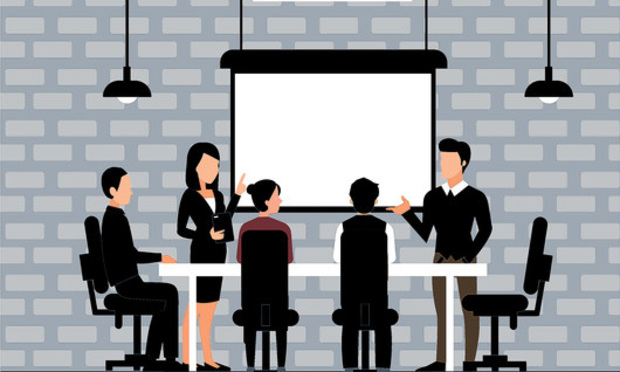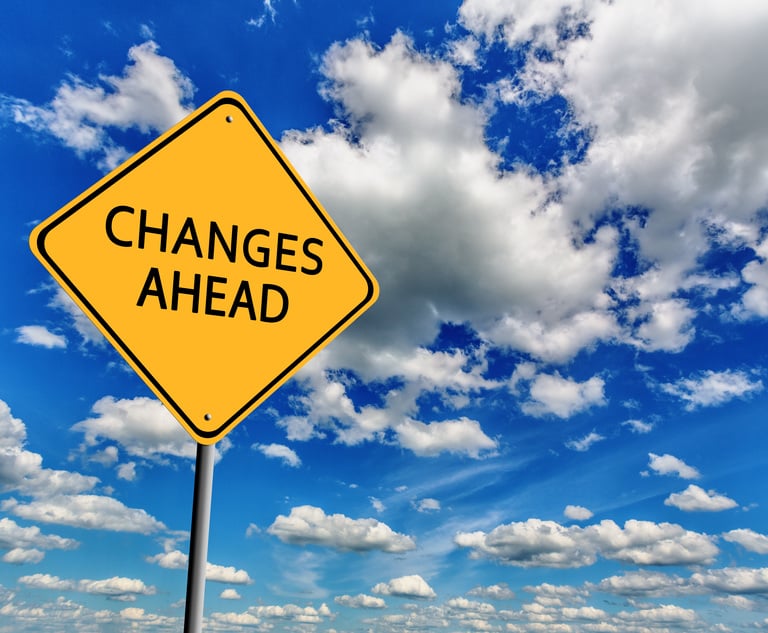Young Lawyers Call For Revamping of Law Firm Offices to Meet New Industry Needs
The American Lawyer's Young Lawyer Editorial Board says reorganizing your office to fit the modern world can optimize work product while reflecting the values of the newest generation of lawyers.
May 03, 2018 at 03:26 PM
9 minute read

By now, you probably roll your eyes at the “millennials are changing everything!” articles that litter your news feed. We also suffer from millennial fatigue. That said, a thorough evaluation of the modern legal workplace requires consideration of millennial values, including how firms and other organizations can improve their output by optimizing the physical workspace.
First, it bears note that office design is not just a feel-good topic—it impacts day-to-day attorney productivity and work product. The three concepts of workspace, work experience and work product are inextricably related. A person whose workspace is comfortable and conducive to the type of work he or she is trying to do will increase cognitive clarity, focus and drive, given the appropriate resources to perform exceptional work. So what environment is comfortable and conducive to the work your attorneys are trying to produce? Or, more succinctly, what do your attorneys need to produce the best results for your firm and its clients?
As with most things in law, that depends.
It depends on the complexity of the task. Is the attorney working on routine matters that are not cognitively demanding—what Cal Newport, author of “Deep Work: Rules for Focused Success in a Distracted World,” has coined “shallow work.” Or is the attorney immersed in a complex matter that pushes his or her cognitive capabilities and requires a distraction-free environment? It depends on work style. Is the attorney an extrovert who thinks by talking things through, or an introvert who would prefer a quiet space to think before discussion? And it depends on personal preferences. Is the attorney more comfortable standing at a working desk in jeans and a button-down, or sitting in a conference room in a suit?
With all of this complexity, it is no wonder that legal organizations—and particularly law firms—have been slow to change on this front.
Law firm workspaces have experienced little change over the last 50-plus years—office with a door, desk with a chair, room lined with file cabinets and books from law school ring a bell? Meanwhile, many of our corporate peers go to work in environments that increasingly resemble upscale coffeehouses attached to fitness centers with game rooms inside—or so it seems.
In law, the three most highly correlated factors that dictate whether associates (a rough proxy for millennials) are happy include interesting work (meaning); partner behavior (mentoring, coaching, getting feedback, developing mastery); and flexibility (autonomy), according to a PD Quarterly article by Avery Blank and Scott Westfahl. As millennials continue to occupy more of the workforce, and as law firms strive to retain the best talent, we encourage law firms to think strategically about the firm's workspace. We urge firms to consider how they might design the workspace in a way that both optimizes the ability of attorneys to focus and responds to millennial values. As a starting point, we suggest thought be given to some specific modernizations.
Create Collaboration Corners
In the last round of office reboots, leadership recognized the need for more conference space and designers responded with additional conference rooms—most of which are adorned with formal tables and chairs. Although these rooms are ideal for depositions and department meetings, they create a level of formality that is often unnecessary and counterproductive for internal meetings. Further, booking these rooms (which, it seems, are always already booked) requires forethought and thus does not allow for the type of informal, extemporaneous conversations that cultivate positive team dynamics. As a result, this impromptu internal collaboration often takes place in attorney offices alongside myriad attendant distractions.
Firms and in-house departments should consider dedicated collaboration space separate and apart from what they share with the outside world. Your firm likely has internal space dedicated to physical file storage that could be converted by shifting files off-site or digitizing them. Hosting a team meeting around a coffee table is more conducive to the sort of focus and collaboration that helps legal teams succeed, and the variety will energize your millennials. The same is true for feedback. So often, good teaching moments are interrupted by a phone call or email. Stepping outside of your office to a dedicated collaboration space will help those interactions be more meaningful and thus keep your millennials engaged.
Reintroduce the Quiet Hum of the Library
Years ago, firms and in-house departments had expansive libraries with all of the print resources needed to do the job. As technology has advanced, law firms have downsized or eliminated these libraries altogether. Your millennials will not miss the books (they are used to accessing resources online), but they will miss those big tables and the energy that comes from working alongside one's colleagues.
If you walk around any law school today, you will see large tables surrounded by aspiring attorneys working away in their textbooks and on their computers—likely with ear buds helping them maintain focus. A few years later, you will find those same attorneys sitting in solitude in their offices, textbooks traded for case files, but computers still nearby. Certainly, there are times where that solitude is necessary, but there are others when the energy and camaraderie of the library is missed.
The law firm of the future will have some of both. Offices, perhaps smaller still, will provide the quiet space necessary for conference calls and brief writing, but “libraries” will return as a place where attorneys can go to break up the day and refuel with the energy of their colleagues.
Offer Technology-Enabled Spaces
High-tech conference rooms are rapidly becoming the expectation in law offices. People are now video conferencing and sharing content virtually, which means that firms should install state-of-the-art technology that allows for efficient and effective virtual collaboration. Employees should be able to share documents in real time while working virtually. (And, no, we are not referring to emails flying back and forth.)
Law firms can facilitate virtual collaboration and enhance in-person teamwork, and thereby increase creativity and productivity through tools such as the Microsoft Surface Hub, which allows everyone to simultaneously provide their input—to contribute to the same virtual whiteboard—in real time. They allow teams to brainstorm and organize ideas, and ensure that ideas and the discussions around them are memorialized in a useful forum. How often have you participated in meetings where co-workers grab a pad of paper, dutifully take notes on the first page, and then return to their offices and throw the pads on stacks of other notepads, never to be referenced again? Hubs consolidate all notes and discussions and allow users to easily save the content for future reference.
Consider Your Office Space as a Network
As Joshua Cooper Ramo stated in his 2017 keynote during the eighth annual Leadership Council on Legal Diversity meeting, connection changes the nature of an object. As he explained it:
“Whether it's a car or a computer, the nature of an object is changed when it's connected. You and I might look at a car and see a car. The people at Uber looked at a car and saw a network, which fundamentally altered its nature. The guys at Airbnb looked at a spare bedroom and understood that it was changed by connection. Something that's connected is different from something that's not.”
If we looked at our legal office space as a network, what would we see? Would it alter the nature of the space? Some firms and companies have already recognized and acted upon the potential that exists, such as building a socially conscious community by opening office doors and inviting charities inside. Big Brothers Big Sisters' Beyond School Walls Program is just one example of such a partnership—“littles” meet their “bigs” at the office, transforming the environment from a work place to a mentoring center for a few hours each month.
Through these outward expressions of core values, leaders communicate important messages to their organizations—messages that are especially important to the millennial generation. In fact, one study of millennials reported that nearly 60 percent were willing to sacrifice 15 percent of their salary to work for an organization whose values they share, according to Lauren Stiller Rikleen's “You Raised Us, Now Work With Us.”
We understand that office design and technology represent significant investments for organizations. We also understand the inherent risk in blindly following trends, such as open space that does not allow for privacy or deep focus, and that organizations do not want to invest in a passing fad. However, we maintain that leaders must be open to rethinking the way they do business and transforming the workplace to attract and retain the next generation of talent.
We are not prescribing a one-size-fits-all solution. Instead, we suggest you thoughtfully engage in this topic at the management level, and take steps to understand what your current and future attorneys need in their workspace to positively influence their work experience, so they can deliver the best work product.
Consider distributing a survey to gather input as to the ideal office space and technology needs, including a seniority question so that you can analyze the data by generation. In the survey, ask your attorneys what they need to feel comfortable, ask them what workspace and technology is conducive to the work they need to achieve and ask them what they need to focus. We anticipate frequent survey answers akin to “it depends,” to which we respond that your guiding force in designing your organization's workspace should be what many millennials crave: flexibility.
The views expressed here are personal to the authors and do not represent the opinions of their employers.
Board Members: Aaron Swerdlow, Alex Tarnow, Andrea Guzman, Andrew Warner, Anusia Gillespie, Aydin Bonabi, Bess Hinson, Blair Kaminsky, Brianna Howard, Brooke Anthony, Emily Stedman, Emma Walsh, Garrett Ordower, Geoffrey Young, Heather Souder Choi, Holly Dolejsi, Jennifer Yashar, Jessica Tuchinsky, Ji Hye You, Josh Sussberg, Kevin Morse, Kyle Sheahen, Lauren Doyle, Martina Tyreus Hufnal, Mauricio Espana, Nicole Gutierrez, Peter Buckley, Quynh Vu, Rakesh Kilaru, Reggie Schafer, Sakina Rasheed Foster, Sara Harris, Shishene Jing, Tamara Bruno, Tim Fitzmaurice, Timothy Perla, Todd Koretzky, Travis Lenkner, Trisha Rich and Wyley Proctor.
This content has been archived. It is available through our partners, LexisNexis® and Bloomberg Law.
To view this content, please continue to their sites.
Not a Lexis Subscriber?
Subscribe Now
Not a Bloomberg Law Subscriber?
Subscribe Now
NOT FOR REPRINT
© 2025 ALM Global, LLC, All Rights Reserved. Request academic re-use from www.copyright.com. All other uses, submit a request to [email protected]. For more information visit Asset & Logo Licensing.
You Might Like
View All
Change Is Coming With the New Trump Era. For Big Law, Change Is Already Here
6 minute read


Letter From London: 5 Predictions for Big Law in 2025, Plus 5 More Risky Ones
6 minute readTrending Stories
- 1Antitrust Partner Plans Move to Davis Polk From Fried Frank
- 2How This Dark Horse Firm Became a Major Player in China
- 3Bar Commission Drops Case Against Paxton—But He Wants More
- 4Pardons and Acceptance: Take It or Leave It?
- 5Gibbons Reps Asylum Seekers in $6M Suit Over 2018 ‘Inhumane’ Immigration Policy
Who Got The Work
J. Brugh Lower of Gibbons has entered an appearance for industrial equipment supplier Devco Corporation in a pending trademark infringement lawsuit. The suit, accusing the defendant of selling knock-off Graco products, was filed Dec. 18 in New Jersey District Court by Rivkin Radler on behalf of Graco Inc. and Graco Minnesota. The case, assigned to U.S. District Judge Zahid N. Quraishi, is 3:24-cv-11294, Graco Inc. et al v. Devco Corporation.
Who Got The Work
Rebecca Maller-Stein and Kent A. Yalowitz of Arnold & Porter Kaye Scholer have entered their appearances for Hanaco Venture Capital and its executives, Lior Prosor and David Frankel, in a pending securities lawsuit. The action, filed on Dec. 24 in New York Southern District Court by Zell, Aron & Co. on behalf of Goldeneye Advisors, accuses the defendants of negligently and fraudulently managing the plaintiff's $1 million investment. The case, assigned to U.S. District Judge Vernon S. Broderick, is 1:24-cv-09918, Goldeneye Advisors, LLC v. Hanaco Venture Capital, Ltd. et al.
Who Got The Work
Attorneys from A&O Shearman has stepped in as defense counsel for Toronto-Dominion Bank and other defendants in a pending securities class action. The suit, filed Dec. 11 in New York Southern District Court by Bleichmar Fonti & Auld, accuses the defendants of concealing the bank's 'pervasive' deficiencies in regards to its compliance with the Bank Secrecy Act and the quality of its anti-money laundering controls. The case, assigned to U.S. District Judge Arun Subramanian, is 1:24-cv-09445, Gonzalez v. The Toronto-Dominion Bank et al.
Who Got The Work
Crown Castle International, a Pennsylvania company providing shared communications infrastructure, has turned to Luke D. Wolf of Gordon Rees Scully Mansukhani to fend off a pending breach-of-contract lawsuit. The court action, filed Nov. 25 in Michigan Eastern District Court by Hooper Hathaway PC on behalf of The Town Residences LLC, accuses Crown Castle of failing to transfer approximately $30,000 in utility payments from T-Mobile in breach of a roof-top lease and assignment agreement. The case, assigned to U.S. District Judge Susan K. Declercq, is 2:24-cv-13131, The Town Residences LLC v. T-Mobile US, Inc. et al.
Who Got The Work
Wilfred P. Coronato and Daniel M. Schwartz of McCarter & English have stepped in as defense counsel to Electrolux Home Products Inc. in a pending product liability lawsuit. The court action, filed Nov. 26 in New York Eastern District Court by Poulos Lopiccolo PC and Nagel Rice LLP on behalf of David Stern, alleges that the defendant's refrigerators’ drawers and shelving repeatedly break and fall apart within months after purchase. The case, assigned to U.S. District Judge Joan M. Azrack, is 2:24-cv-08204, Stern v. Electrolux Home Products, Inc.
Featured Firms
Law Offices of Gary Martin Hays & Associates, P.C.
(470) 294-1674
Law Offices of Mark E. Salomone
(857) 444-6468
Smith & Hassler
(713) 739-1250










